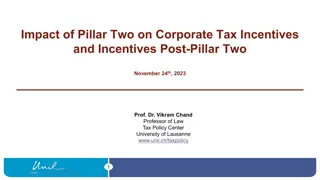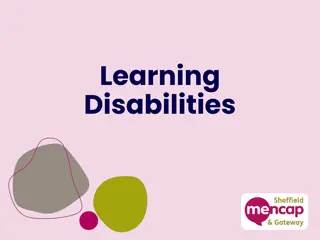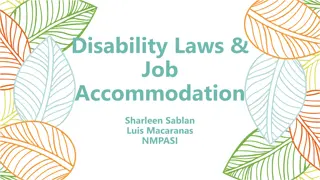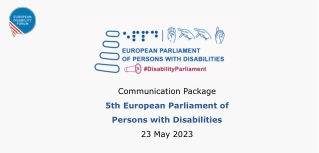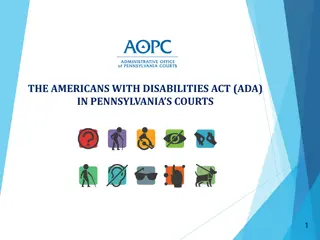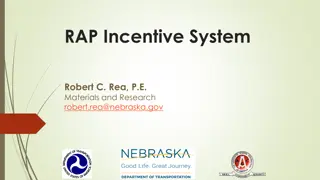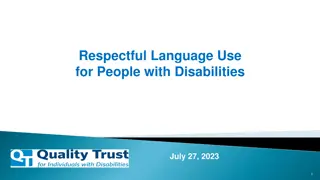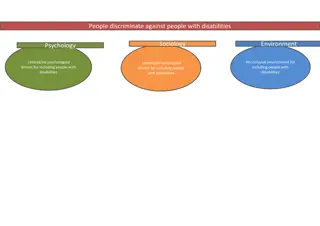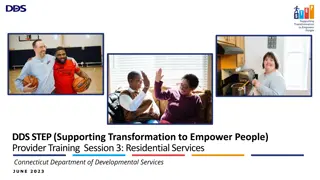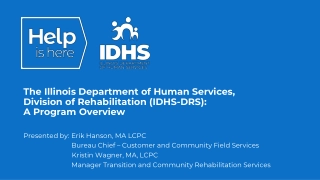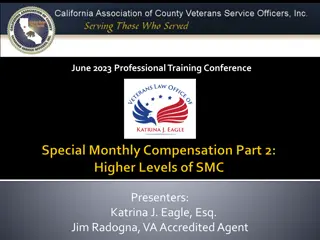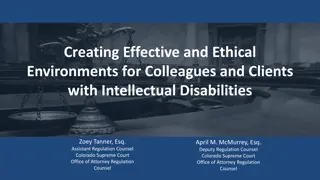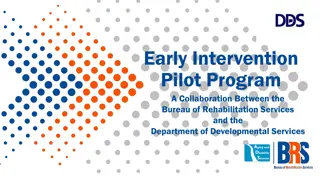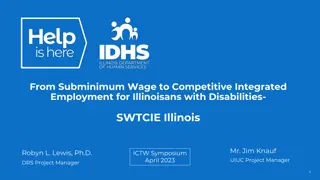Employer Incentives for Hiring People with Disabilities
Learn about the various employer incentives available to promote the hiring and retention of individuals with disabilities, including tax credits like the Work Opportunity Tax Credit (WOTC). Hiring people with disabilities not only brings financial benefits but also enhances diversity, morale, productivity, and corporate citizenship. The Vocational Rehabilitation Technical Assistance Center for Quality Employment aims to increase employment outcomes for individuals with disabilities through innovative strategies and support practices.
Download Presentation
Please find below an Image/Link to download the presentation.
The content on the website is provided AS IS for your information and personal use only. It may not be sold, licensed, or shared on other websites without obtaining consent from the author. Download presentation by click this link. If you encounter any issues during the download, it is possible that the publisher has removed the file from their server.
Presentation Transcript
Employer incentives to promote the hiring and retention of people with disabilities A joint presentation by the Vocational Rehabilitation Technical Assistance Center for Quality Employment tacqe.com
Presented by Emily Brinck Researcher- VRTAC-QE University of Wisconsin-Madison Deborah Lee Researcher- VRTAC-QE University of Wisconsin-Madison tacqe.com
Vocational Rehabilitation Technical Assistance Center for Quality Employment Goal: The Technical Assistance Center for Quality Employment will increase the number and quality of employment outcomes for individuals with disabilities through training and technical assistance to State VR agency personnel. The VRTAC-QE will support State VR agency personnel to implement innovative and effective employment strategies and supporting practices. tacqe.com
Acknowledgement & Disclaimer: The contents of this presentation were developed under a grant, the Vocational Rehabilitation Technical Assistance Center for Quality Employment, H264K200003, from the U.S. Department of Education. However, those contents do not necessarily represent the policy of the U.S. Department of Education, and you should not assume endorsement by the Federal government.
Presentation Overview Benefits of hiring people with disabilities Overview of tax incentives
Benefits of Hiring People with Disabilities Beyond financial benefits, hiring people with disabilities can: Increase company diversity Increase overall morale Increase productivity Enhance public image Promote good corporate citizenship
Work Opportunity Tax Credit The Work Opportunity Tax Credit (WOTC) is a Federal tax credit available to employers for hiring individuals from certain targeted groups, including: the formerly incarcerated or those previously convicted of a felony; recipients of state assistance under part A of title IV of the Social Security Act (SSA); veterans; individuals referred to an employer following completion of a rehabilitation plan or program; individuals whose families are recipients of supplemental nutrition assistance under the Food and Nutrition Act of 2008; recipients of supplemental security income (SSI) benefits under title XVI of the SSA; individuals whose families are recipients of state assistance under part A of title IV of the SSA; individuals experiencing long-term unemployment
Work Opportunity Tax Credit The Work Opportunity Tax Credit, or WOTC, is a general business credit provided under section 51 of the Internal Revenue Code (Code) that is jointly administered by the Internal Revenue Service (IRS) and the Department of Labor (DOL). The WOTC is available for wages paid to certain individuals who begin work on or before December 31, 2025. The WOTC may be claimed by any employer that hires and pays or incurs wages to certain individuals who are certified by a designated local agency (sometimes referred to as a state workforce agency) as being a member of one of 10 targeted groups.
WOTC- Tax Credit Overview In general, the WOTC is equal to 40% of up to $6,000 of wages paid to, or incurred on behalf of, an individual who: is in their first year of employment; is certified as being a member of a targeted group; and performs at least 400 hours of services for that employer. The maximum tax credit is generally $2,400. A 25% rate applies to wages for individuals who perform fewer than 400 but at least 120 hours of service for the employer.
WOTC- Who can claim? Up to $24,000 in wages may be taken into account in determining the WOTC for certain qualified veterans. An employer cannot claim the WOTC for employees who are rehired. Taxable employers may carry the current year s unused WOTC back one year and then forward 20 years. Employers of all sizes are eligible to claim the WOTC. Available to both taxable and certain tax-exempt employers Taxable employers claim the WOTC against income taxes Tax-exempt employers can claim the WOTC only against payroll taxes and only for wages paid to members of the Qualified Veteran targeted group.
Claiming the WOTC On or before the day that an offer of employment is made The employer and the job applicant must complete Form 8850 (Pre-Screening Notice and Certification Request for the Work Opportunity Credit). The employer has 28 calendar days from the new employee s start date to submit Form 8850 to the designated local agency in which the business is located (where the employee works). Additional forms may be required by the DOL to obtain certification. Following receipt of a certification from the designated local agency that the employee is a member of one of the 10 targeted groups, employers must file: Taxable employers file Form 5884 (Work Opportunity Credit) Tax-exempt employers file Form 5884-C (Work Opportunity Credit for Qualified Tax-Exempt Organizations Hiring Qualified Veterans)
Disabled Access Credit The Disabled Access Credit is a tax credit that qualifying small business owners can claim for incurring eligible access expenses. Eligible access expenses are costs businesses incur when they Remove barriers that prevent accessibility for individuals with disabilities Provide qualified interpreters or make audio materials available to hearing-impaired individuals Provide qualified readers, taped texts, and other ways to make visual materials available to visually-impaired individuals Acquire or modify equipment or devices for individuals with disabilities Qualifying small businesses $1 million or less in gross receipts for the preceding tax year OR had 30 or fewer full-time employees Elect to claim the disabled access credit for the tax year
Disabled Access Credit To receive the credit, the expense must be reasonable and necessary. Expenses to increase accessibility of facilities are limited to adaptation of current buildings, not for new construction. Disability tax credit amount The disability credit is worth 50% of your eligible access expenses, up to a maximum of $10,250. You cannot claim a credit for the first $250 in expenses. The maximum tax credit you can claim is $5,000.
Disabled Access Credit example Example, the addition of a wheelchair ramp to your place of business to accommodate a person with a disability (i.e., employee, customer) costs $8,250. $8,250 - $250 = $8,000; $8,000 * 50% = $4,000 You would be eligible for up to a $4,000 tax credit If the ramp cost $15,250, and you applied the Disabled Access Credit $15,250 -250= $15,000; Maximum credit is $5,000 But Businesses may use the Disabled Tax Credit and the architectural/transportation tax deduction together in the same tax year, if the expenses meet the requirements of both sections. To use both, the deduction is equal to the difference between the total expenditures and the amount of the credit claimed.
Not eligible for the Disabled Access Credit? Businesses that incur eligible access expenses can claim a maximum deduction of $15,000 per year. Any size business that spends money making their facility or public transportation vehicle more accessible to persons with disabilities can claim the deduction. Businesses claim the deduction by listing it as a separate expense on their income tax return. https://www.irs.gov/pub/irs-pdf/p535.pdf Section 7- Barrier removal costs
For more information: Please go to the IRS website: https://www.irs.gov/businesses/small-businesses-self-employed/tax-benefits- for-businesses-who-have-employees-with-disabilities
Thank you! Presenters VRTAC-QE www.tacqe.com contact@tacqe.com tacqe.com



